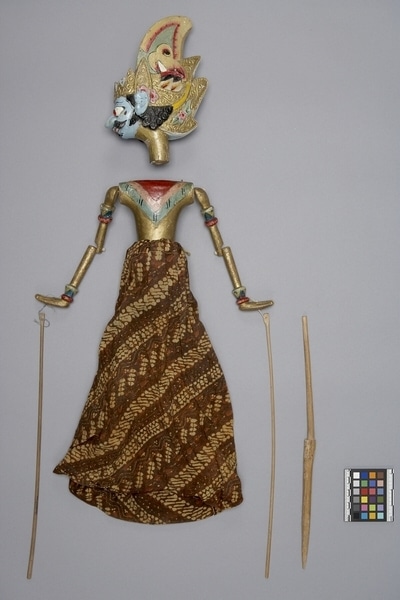Rod Puppet Item Number: Ib340 from the MOA: University of British Columbia


Description
Humanoid figure puppet in three parts: head (part b), body (part a), pointed controlling rod (part c), and slender spherical controlling rod. Face, ears coloured blue; hooked nose, bulging white eyeballs with red irises, heavy black moustache. Red lips, protruding white teeth, no fangs. Red teardrop shape outlined in black on each cheek. Headdress has gold jamang, sumping, badong, and siyung jawi, with light red flower and green leaf motifs. Badong has two prongs; siyung jawi has yellow stripe at base. Gold, yellow and red Garuda Mungkur has red flower motifs, green leaves, white fang. Gold body has red, blue striped yoke, front and back. Gold arms have blue, yellow, red ornaments at bicep, wrist. One small nail on each shoulder, one centre chest. Kain has brown diagonal batik design. Operating rod unpainted, spear-shaped; fits through body, turns head. Body has white label: 'Suyadana Ondste ud Pandawa.' also black pen mark: 'I.S.J.D.N.'. Chipped paint on face, body, arms.
History Of Use
Javanese puppetry as an art form probably developed by the 11th century. The three-dimensional wooden wayang golek puppets of western Java appeared during the 16th century. Originally the plays depicted Javanese mythology, but after the Indian conquest of Java the Hindu epics, Ramayana and Mahabharata, were incorporated into the cycles, which comprise about 200 plays. An individual or group hires a dalang (puppet-master) to celebrate important occasions. The performances often last all night and are generally presented in three acts, with vocal and instrumental accompaniment. The individual plays vary widely in detail but usually involve conflict between good and evil. They serve a moral and religious purpose, and more recently, one of political commentary. Each puppet's character is represented by its appearance and placement onstage; protagonists with strong elements of good are placed to the right, antagonists of violent or evil nature to the left. Suyudana appears in the Pandawa cycle, which details the struggle between the evil Kurawa brothers and the good Pandawa brothers. As the most important of the Kurawas, Suyudana, would appear to the left of the stage. The cycle spans twelve generations, from the first, divine ancestors of the two families to the final battle, the Bratayada, in which the evil group is ritually defeated, although not without inflicting great losses.
Iconographic Meaning
The sekar kluwih headdress, the diadem, the batik kain, blue face, large eyes with red irises, prominent hooked nose, heavy moustache and short beard are all distinguishing features of Suyudana, or Durjudana, known by many other names. He is the eldest of the Kurawa brothers, King of Astina, son of King Dasarata and Dewi Gandari, nephew of Sangkuni and chief of the enemies of the Pandawa brothers. He is of human descent; thus, the three nails probably held a chest covering. The batik kain and gold torso indicate his high rank (satrya) but the robust body and direct gaze show that he is strong and forthright. He is not as refined as most good characters, although he is distinguished. Suyudana is considered pugnacious and courageous, a generous ruler whose main fault is that he cannot refuse his basely motivated younger brothers. His ethically ambivalent nature is reflected in the two prefixes to his name: su (good) and dur (evil).
Cultural Context
Theatrical performance.
Item History
- Made in Java, Indonesia
- Owned by Tradewind Antiques before March 15, 1983
- Received from Museum of Anthropology Shop Volunteers (Funding source) and Tradewind Antiques (Seller) on March 15, 1983
What
- Name
- Rod Puppet
- Identification Number
- Ib340
- Type of Item
- puppet
- Material
- wood, cotton fibre, paint and iron metal
- Manufacturing Technique
- carved, machine woven, dyed, sewn, painted, drilled and forged
- Part A
- height 67.0 cm, width 20.0 cm, depth 9.2 cm
- Part B
- height 25.2 cm, width 8.7 cm, depth 15.0 cm
- Part C
- height 41.0 cm, width 2.1 cm, depth 1.7 cm
Who
- Culture
- Sundanese
- Previous Owner
- Tradewind Antiques
- Received from
- Museum of Anthropology Shop Volunteers (Funding source) and Tradewind Antiques (Seller)
Where
- Holding Institution
- MOA: University of British Columbia
- Made in
- Java, Indonesia
When
- Ownership Date
- before March 15, 1983
- Acquisition Date
- on March 15, 1983
Other
- Condition
- fair
- Accession Number
- 0886/0074